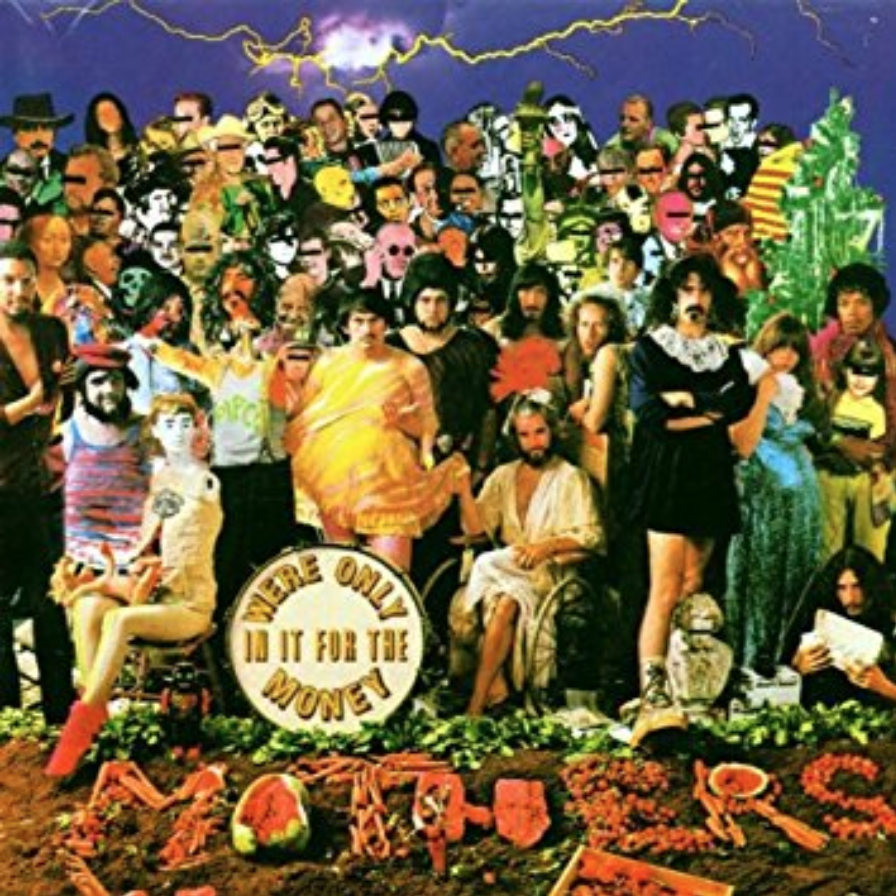
A lot can be said about Frank Zappa’s 1968 satire, “We’re Only in It for the Money”. For starters, if you look closely, Jimi Hendrix is on the cover, and he was actually there, because he was friends with Zappa. Vocals from Eric Clapton are featured in one of the album’s skits. Villains, killers, and LBJ are hidden in the crowd. To top it off, there is thunder in the sky, mocking the joy and perfection of Sgt. Peppers and his Lonely Hearts Club Band.
While that Beatles album is widely considered perfect, there is nothing perfect about this album. It is a perfect disaster, but in the best way possible. In fine Zappa form, it carelessly wanders from one idea to the next, painting a large picture of dissatisfaction and resentment of the increasingly fraudulent free love culture that took over the nation. Zappa did not do drugs, identified as a staunch Libertarian, and deeply resented what he saw as high-flying ideals of the left. This may shock many, who also remember him for naming his daughter ‘Moon Beam’.
As a studio artist in San Francisco in 1968, he demanded total perfection from studio players, who were often ill-prepared for his totalitarian studio tendencies. There are a few noted instances where he demanded that his musicians play in time signatures that were either baffling or outright impossible.
Zappa saw his operation as a fine tuned machine, and felt that his players were paid handsomely. They could either tolerate his high demands, or find other work.
All of this was totally foreign to a culture of free loving, acid-tripping, commune living, long haired dudes who were perhaps more accustomed to the jug band fun of the Lovin’ Spoonful.
Zappa felt that youth culture was being commodified and sold, and he thought that The Beatles were a symbol of this excess.
When the album was finally coming to fruition, as the story goes, he called Paul McCartney to explain the project and ask permission to use the satirical cover. McCartney told him that this was an issue to take up with the label, who staunchly objected to Zappa’s album art. This delayed the release of the album for five months.
In between bewildering vocal breaks lie heavily rhythmic, totally ruthless, and incredibly angry songs like “Harry, You’re a Beast”, which lay hippie culture to waste for its excesses and flaws.
“What’s the Ugliest Part of Your Body” is a mockery of the Sgt. Pepper’s medley that instead tells hippies that their children are ‘poor unfortunate victims of lies [they] believe.’
“Flower Punk” tells the story of a middle-aged man who tunes in and drops out, ‘playing his bongos in the sand.’
We often are saturated with images of free loving spirits in light clothing, hand in hand preaching love against war. We remember Woodstock, as John Sebastian, Carlos Santana and Jimi Hendrix played songs that were heard around the world. We’re Only In it for the Money is essential, because it paints a more complete picture of a country where conservatives would soon retake the White House, where counter protesters with clubs shocked peace marches, and, to be frank, where hippie culture was to many nothing more than a fashion trend.
This unapologetic concept album laid the groundwork for Zappa to pursue his career of cynical rejectionism.
Yet, despite the anger that drives the album, it is funny, smart, enjoyable, and, when it chooses to be, easy to approach.
Zappa fans often muse about the albums you give a non-believer to get them hooked. This is an album that I often preach when asked.
Standout Tracks:
“Absolutely Free”
“Who Needs the Peace Corps”
“Harry, You’re a Beast”
“Flower Punk”
“Let’s Make the Water Turn Black”
By Jacob Newman

